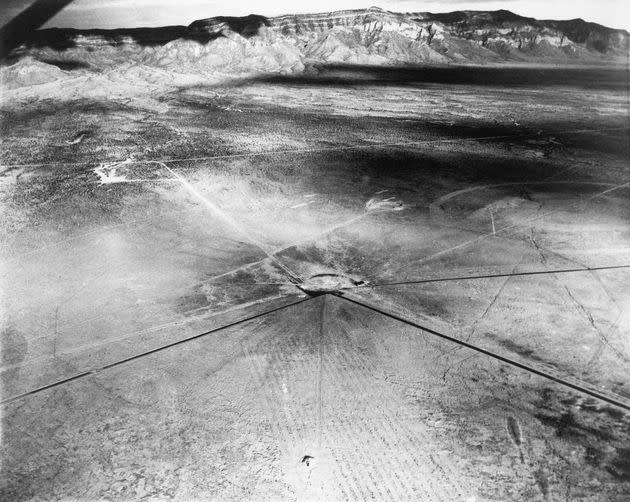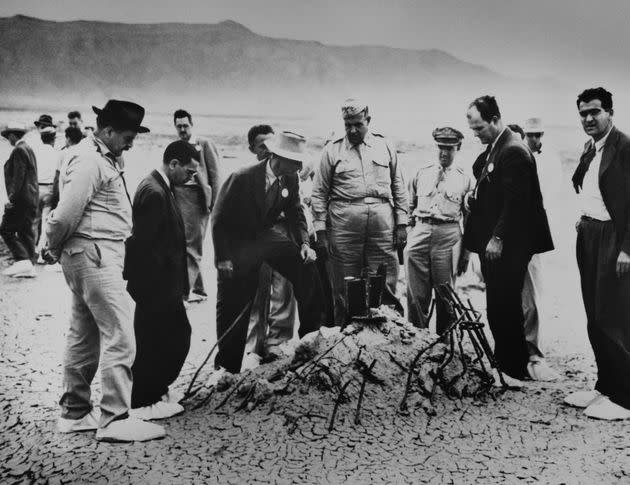Senate Votes To Compensate Victims Of ‘Oppenheimer’ Nuclear Test
- Oops!Something went wrong.Please try again later.
- Oops!Something went wrong.Please try again later.
WASHINGTON ― The Senate on Thursday approved a measure that would, for the first time, give health care benefits and compensation to communities impacted by the test of the first atomic nuclear bomb in New Mexico.
The “Trinity” nuclear test is featured in Christopher Nolan’s latest hit movie “Oppenheimer,” which focuses on the life of physicist J. Robert Oppenheimer and his role in leading the Manhattan Project, a top-secret U.S. government program that began during World War II.
What the film doesn’t mention, however, is the array of deadly cancers that afflicted people exposed to radiation who lived “downwind” in the area near Alamogordo, New Mexico, for decades afterward ― many of whom were Native Americans and other people of color. The fallout traveled in a northern direction, affecting people as far away as Colorado, Idaho and Montana.
“Millions of people across the country traveled to theaters this weekend to watch a blockbuster centered around this infamous day, but not enough people have focused on the collateral damage caused by our nation’s nuclear testing,” New Mexico Sen. Ben Ray Luján said Thursday in a speech on the Senate floor.

This aerial view of the atomic bomb testing site near Alamogordo, New Mexico, shows the shallow crater dug by the blast 300 feet around the tower from which the bomb hung. The sand in an area 2,400 feet around the tower was seared into jade green glasslike cinders. The area devastated by the bomb measures 4,800 feet in diameter, and the steel tower was entirely disintegrated.
Luján called attention to the consequences for his home state in a series of tweets posted last week ahead of the movie premiere, noting that thousands of victims and their family members continue to face health complications.
In 1990, Congress passed the Radiation Exposure Compensation Act, which compensated many communities affected by U.S. military nuclear explosions. The law excluded survivors of the Trinity test, however, and lawmakers and native tribes in New Mexico have been seeking to right that wrong ever since.
“Those families were not given any warning, any heads up, they saw a bright light, they saw ash fall on their clothing lines, but for some reason they were excluded as a county that should qualify for status. It makes zero sense,” Luján told HuffPost.
Working alongside Sen. Josh Hawley (R-Mo.), Luján sponsored an amendment to the National Defense Authorization Act that would include previously excluded communities harmed by radiation from above-ground nuclear weapons testing, as well as uranium mining and nuclear waste storage in other states. It was adopted on Thursday in a bipartisan 61-37 vote.
Hawley, who was spotted whipping his GOP colleagues to vote for the measure in the well of the Senate chamber, credited Nolan’s film for raising awareness to an issue that has affected people in his state who lived near a Manhattan Project nuclear processing facility.

Robert Oppenheimer and General Leslie Groves (center) examine the twisted wreckage in Alamogordo, New Mexico, that is the only remains of a 100-foot tower, winch and shack that held the first nuclear weapon. On the far right is Victor Weisskopf, of the Manhattan Project's Theoretical Division.
“For us, it’s about getting some basic justice for the people in the St. Louis region who have gotten literally poisoned,” Hawley said.
The Senate is expected to pass its version of the National Defense Authorization Act this week. The House already approved the bill earlier this month, though it included several partisan GOP amendments on hot-button social issues. The two sides will have to hash out their differences in a conference committee, including over the Senate amendment extending benefits to victims of nuclear tests.
Luján said he hadn’t yet watched “Oppenheimer,” so he couldn’t weigh in as to its accuracy and its portrayal of how the nuclear testing affected the people of New Mexico.
“I don’t know that anyone can ever give this a fair shake,” he said of the movie. “You have to hear the stories of these families. Many of our brothers and sisters have since passed. I’m hopeful that attention around the movie brings attention to this travesty because this deserves attention.”
